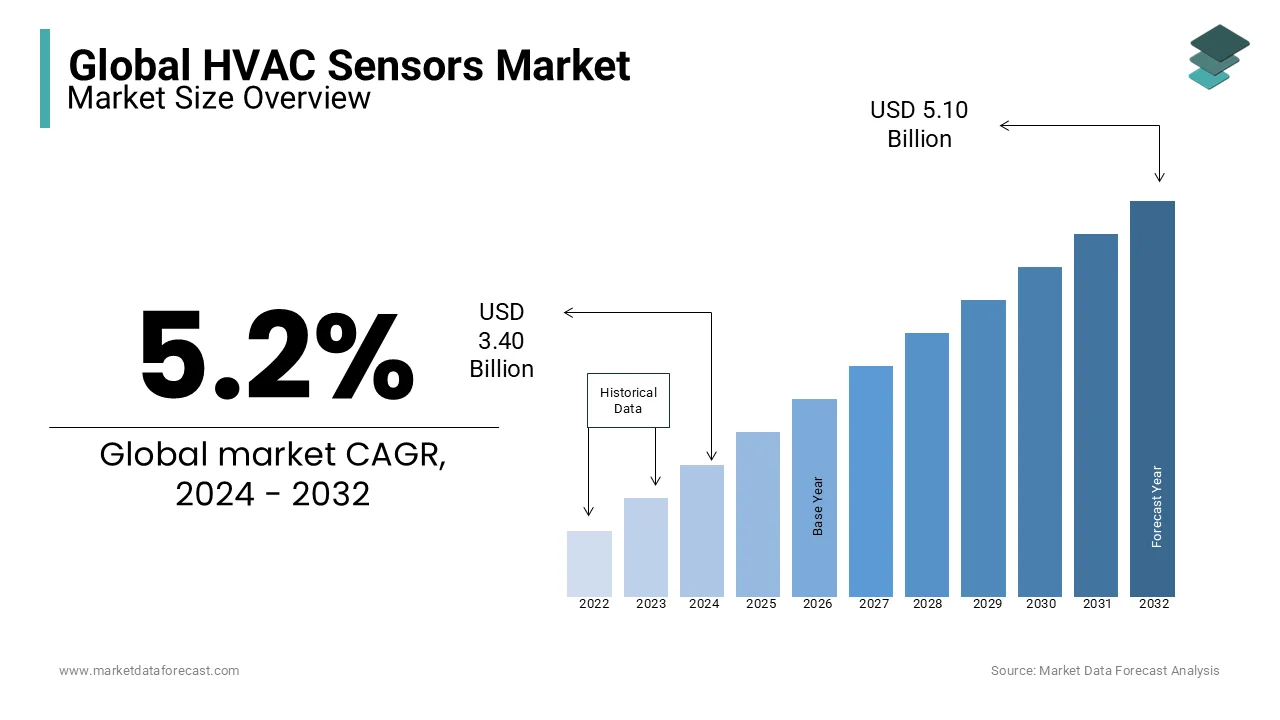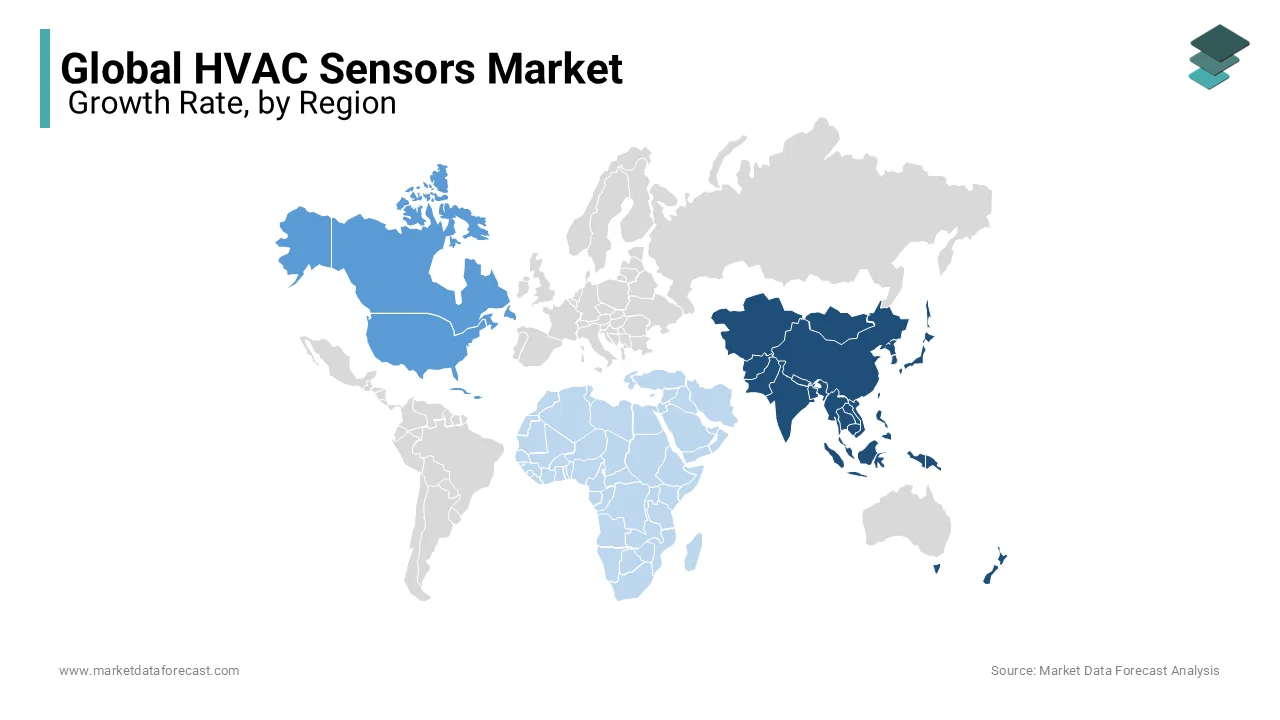Global HVAC Sensors Market Size, Share, Trends, & Growth Forecast Report - Segmented By Type (Temperature, Humidity sensor, Pressure sensor, and Air Quality sensor), By Application (Duct, Residential, Industrial and Transportation & Logistic), By End-Use (Commercial, Domestic, and Industrial), & Region - Industry Forecast From 2024 to 2032
Global HVAC Sensors Market Size (2024 to 2032)
As per our analysis report, the global HVAC Sensors Market was valued at USD 3.23 billion in 2023. The global market is expected to reach USD 5.10 billion by 2032 from USD 3.40 billion in 2024, growing at a compound annual growth rate (CAGR) of 5.2% during the forecast timeline.

Current Scenario of the Global HVAC Scenario Market
The most common sort of HVAC sensor is used to differentiate between input and building or room temperatures, assisting in maintaining the appropriate temperature and adjusting the needed temperature.
HVAC systems are commonly utilized to manage, maintain, and thereby lower energy use. An audio device that replicates a genuine condition, such as temperature and target world, is included in the frequency. HVAC sensors can manage, regulate, and monitor many tasks for end-users such as industrial, residential, and commercial buildings, such as air pressure, temperature, and quality. As a result of the requirement to save energy, HVAC sensors are becoming increasingly popular. Even government organizations are interested in how HVAC sensors might change the energy utilized in industrial and commercial facilities. HVAC sensors are primarily used in ducts, chambers, cables, walls, immersions, and other applications that will be important in the future.
MARKET DRIVERS
In growing economies such as APAC, MEA, and SAM, the construction sector is booming, with significant investment in commercial buildings as well as infrastructural and institutional projects such as railway stations, bus stations, airports, and educational institutions.
The fast rise of the building industry can be linked to an increasingly urban population desiring a higher standard of life. Furthermore, the increased commercial construction of retail malls, leisure centers, movie halls, and office buildings is increasing the installation of HVAC systems.
Furthermore, several of these economies intend to improve their industrial sectors by providing a favorable business climate for international investors as well as assistance to domestic industries. Government programs to assist industrialization include Made in China 2025, Make in India, the Saudi Arabia National Industrial Development & Logistics Program, and the UAE Strategy for the Fourth Industrial Revolution which drives the market to grow in the future.
MARKET RESTRAINTS
Because of the high costs connected with establishing the systems, the number of HVAC systems being implemented in industrialized nations is rapidly growing. Furthermore, a lack of awareness about HVAC standards limits the growth of the HVAC sensors market during the forecast period. Many HVAC businesses operate on an ad hoc, centralized basis, limiting their capacity to adapt to a modern digital system capable of serving consumers on a larger scale.
REPORT COVERAGE
|
REPORT METRIC |
DETAILS |
|
Market Size Available |
2023 to 2032 |
|
Base Year |
2023 |
|
Forecast Period |
2024 to 2032 |
|
CAGR |
5.2% |
|
Segments Covered |
By Type, Application, End-Users, and Region |
|
Various Analyses Covered |
Global, Regional & Country Level Analysis, Segment-Level Analysis, DROC, PESTLE Analysis, Porter’s Five Forces Analysis, Competitive Landscape, Analyst Overview on Investment Opportunities |
|
Regions Covered |
North America, Europe, APAC, Latin America, Middle East & Africa |
|
Market Leaders Profiled |
Daikin, Ingersollrand, Johnsoncontrols, LG Electronics, United Technologies, Electrolux, Emerson, Honeywell, Lennox, Mitsubishi Electric, Nortek, Samsung Electronics and Others. |
SEGMENTAL ANALYSIS
Global HVAC Sensors Market By Type

Compressors, boilers, coolers, heat recovery systems, burner control, and variable air volume systems all require pressure sensors. They monitor rooms and filters for pressure decreases that may signal that the system requires repair. Pressure monitoring is also important for improving airflow, heating, and cooling.
Global HVAC Sensors Market By End Users
HVAC sensors are widely used by end users in industrial and commercial settings where the demand for HVAC sensors is greater.
REGIONAL ANALYSIS

The Asia-Pacific HVAC sensors market is dominant and will account for the highest share over the projected period.
South Asian nations provide significant assistance to the HVAC Sensor industry. The market for HVAC sensors is increasing in nations such as India and China due to increasing populations, rising consumer spending, and diverse climatic conditions. Southeast Asia is predicted to reach 295 million units of consumption by 2040.
North America is expected to have a sizable share of the HVAC sensors market. According to the US Department of Energy, heating and cooling account for roughly 45 percent of the average household's power bill. According to the National Electrical Manufacturers Association, the US government consumes approximately 45 percent of all energy (NEMA).
Europe is expected to expand significantly in the HVAC Sensor market. The European market is expanding due to an increase in demand for replacing older systems with newer, more complex controllers. The expansion of smart cities across Europe promotes the growth of the HVAC Sensors market. The European government is focusing more on establishing smart cities, which is driving the market's growth. BELIMO introduced a new ultrasonic flow sensor for HVAC applications in March 2020.
The Latin American HVAC sensors market has grown significantly as a result of an expansion in the number of different industrial verticals due to the availability of inexpensive labor and foreign investments. Brazil leads the HVAC sensors market with the greatest perforation and the fastest-growing smartphone use worldwide. Brazil is working on performing temperature sensors in wearable devices connected via cell phones.
The HVAC Sensor market in the Middle East and Africa is expected to expand rapidly. The increasing acceptance and industrialization of new technologies are impacting many industries and are related to market growth. The African HVAC Sensor market is likely to develop at a rapid pace in the coming years. Rising customer demand for lower-cost, energy-efficient products drives market demand.
KEY MARKET PLAYERS
Major Key Players in the Global HVAC sensor market are Daikin, Ingersollrand, Johnsoncontrols, LG Electronics, United Technologies, Electrolux, Emerson, Honeywell, Lennox, Mitsubishi Electric, Nortek, and Samsung Electronics.
RECENT HAPPENINGS IN THE MARKET
- Gardner Denver completed its merger with Ingersoll Rand's Industrial business on February 29, 2020. With an expanded product line, the newly formed corporation, Ingersoll Rand Inc., will have significant market dominance in the market for mission-critical flow control and industrial technology.
- Honeywell announced a new airborne particle on December 7, 2020, that uses AI and cloud computing to enable HVAC service providers and environmental testing specialists.
- Siemens launches its new Climatix Rooftop Unit (RTU) optimization solution on March 13, 2021. The system is designed to improve the efficiency of small-to-large-scale buildings such as restaurants, businesses, and K-12 facilities.
DETAILED SEGMENTATION OF THE GLOBAL HVAC SENSORS MARKET INCLUDED IN THIS REPORT
This research report on the global HVAC sensors market has been segmented and sub-segmented based on type, application, end-user, and region.
By Type
- Temperature Sensors
- Humidity Sensors
- CO Sensors
- CO2 Sensors
- Air Velocity Sensors
- Pressure / Occupancy Sensors
- Flow Sensors
- Others
By Application
- Room
- Duct
- Outdoor
- Cables
- Wall
- Immersion
- Others
By End-users
- Commercial
- Residential
- Industrial
- Transportation & Logistics
By Region
- North America
- Europe
- Asia Pacific
- Latin America
- Middle East and Africa
Frequently Asked Questions
What types of sensors are most commonly used in HVAC systems?
Commonly used sensors in HVAC systems include temperature sensors, humidity sensors, pressure sensors, occupancy sensors, air quality sensors (e.g., CO2 and VOC sensors), and flow sensors. Each type serves a specific role in maintaining the efficiency and safety of HVAC systems.
How is IoT impacting the HVAC sensors market globally?
IoT is revolutionizing the HVAC sensors market by enabling real-time data collection, remote monitoring, and predictive maintenance. IoT-integrated HVAC sensors can optimize energy use, reduce operational costs, and provide insights into system performance, leading to more intelligent and automated HVAC systems.
Which industries are driving the demand for HVAC sensors?
Industries such as commercial real estate, data centers, pharmaceuticals, healthcare, automotive, and manufacturing are key drivers of HVAC sensor demand. These industries require precise climate control and monitoring, making HVAC sensors essential for maintaining air quality, temperature, and humidity.
What are some notable technological trends shaping the HVAC sensors market?
Key technological trends include the development of smart sensors with AI and machine learning capabilities, wireless sensors, and cloud-based monitoring solutions. Sensors with self-calibration features, energy harvesting technology, and predictive analytics are also gaining traction in the HVAC industry.
Related Reports
Access the study in MULTIPLE FORMATS
Purchase options starting from
$ 2500
Didn’t find what you’re looking for?
TALK TO OUR ANALYST TEAM
Need something within your budget?
NO WORRIES! WE GOT YOU COVERED!
Call us on: +1 888 702 9696 (U.S Toll Free)
Write to us: sales@marketdataforecast.com